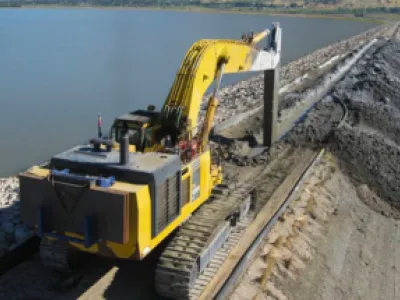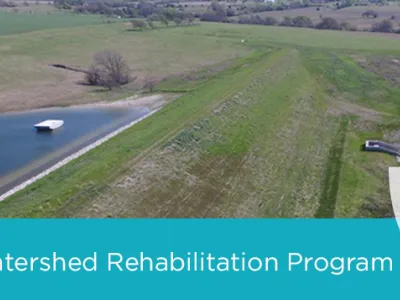Each year, dozens of lives are lost on America’s waterways at structures called low-head or “run-of-the-river” dams. Among the victims are boaters, kayakers, swimmers, anglers and emergency responders.
Low-head dams are characterized by their low height — usually with a one foot to 15 foot drop off — which allows water to flow over the top of the dam. Below the surface, the water falling over the dam creates highly aerated, circulating currents that trap people and objects underwater against the face of the dam. These forces are a practically inescapable trap for even the strongest, life-jacket-clad swimmer or boats and kayaks. People are often unaware of these dangers, or they underestimate their risk of falling victim to them. Due to this danger, these structures have earned the title of “the killer in our river” or “drowning machines.”
The late Dr. Bruce Tschantz, professor emeritus of the University of Tennessee, documented 377 fatalities at low-head dams from 1960 to August 2016, with the majority – 91 percent – occurring from April through August during the summer recreation season. Swimming, boating and fishing account for most incidents at dams in the United States.
If you choose to go out on a waterway for recreational purposes, make sure to study the area closely beforehand, or ask a local for more information about dam locations. It is important to be aware of the location of these structures, so you are ready to exit the water if you are approaching one. As you go out, make sure you follow these tips:
-
Study a map beforehand to locate potential dams and hazard locations or ask a local for more information about dam locations.
-
Always be alert for potentially dangerous situations.
-
Always portage around the structure or turn around well before reaching the dam when kayaking, canoeing or boating.
-
Obey all posted signage and barriers in the area.
-
Let someone know when and where you are heading out and when to expect your return.
-
Never enter the water to try and help someone. Instead, call 911 and use a remote assistive device, such as a rope or throw bag, to try and pull them back to safety.
It is also helpful to get in touch with local recreation outfits, such as kayak and boat rentals, hiking groups, conservation groups, and others to discuss their education programs. These groups are often the best experts in the area and can be a great resource.
The most important tip is to remember — “Keep Your Distance, Keep Your Life”: Always stay a safe distance away from dams both upstream and downstream to avoid drowning.
There are many free resources available to aid in better understanding the dangers of low-head dams and the importance of this issue. In cooperation with state dam safety programs, the Association of State Dam Safety Officials (ASDSO) has launched numerous programs and resources to provide dam owners, dam operators and the public with crucial safety information. The ASDSO public safety website houses safety guidelines, training and accessible education about low-head dams and many other types of dams. ASDSO has also partnered with the Indiana Silver Jackets to share two awareness videos, “Over, Under, Gone” and “Be a Dam Champion,” which can be found for free at the ASDSO website. Both videos are aimed at a teenage to young-adult audience.
Currents around low-head dams can be swift and unpredictable. It is critically important to not only understand the scope of this danger but also to be aware of the many ways you can keep yourself and others safe and avoid a tragedy. And remember — Keep Your Distance, Keep Your Life.
Additional Resources
1. ASDSO Public Safety Website
This site includes a detailed explanation of 16 common hazards, the latest statistics, best practices, a compilation of recent news coverage and more.
2. Over, Under, Gone – 28 Minute Video
Over, Under, Gone is a short documentary that focuses on low-head dams. It covers many aspects of the issue including the dangers, the history of low-head dams, and challenges of dam removal. It also provides the perspective of friends and family of a drowning victim in Indiana.
3. Be a Dam Champion – 14 Minute Video
Leah Pritchett is an American drag racer. Since the moment she first hit the throttle in a Junior Dragster at 8 years old, she only had one ambition, to be a champion. In this video, Leah helps to show the dangers of low-head dams and urges others to be a champion by avoiding this 'opportunity for disaster.'
4. Identifying Hazards and Improving Public Safety at Low Head Dams – 2 Hour Webinar
This webinar will provide participants with an understanding of the hidden dangers at low head dams and effective strategies for improving public safety. The instructors will illustrate their presentation with several examples drawn from their own experiences as hydraulic/civil engineers, expert witnesses, authors and engineering designers.
5. Animation: Dangers of Low-Head Dams
This easy to understand animation is part of the official Indiana boating safety course.
6. Hidden Dangers and Public Safety at Low-Head Dams – Article from the Journal of Dam Safety
A recent study of accidents at these dams over the last four decades reflects a sobering reality of the problem from a national hazard perspective. The hydraulic action below low-head dams is reviewed to show how it creates a water hazard, threatening public safety. Structural and non-structural measures to reduce drownings are examined and a drowning case study is presented that the authors have investigated.
7. What We Know (and Don’t Know) About Low-Head Dams - Article from the Journal of Dam Safety
Low-head, or run-of-the-river, types of dams - usually spanning the entire river or stream - can present a safety hazard to the public because of their capability to produce dangerous recirculating currents, large hydraulic forces, and other hazardous conditions sufficient to trap and drown victims immediately downstream from the overflowing water





































